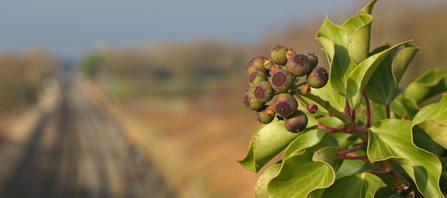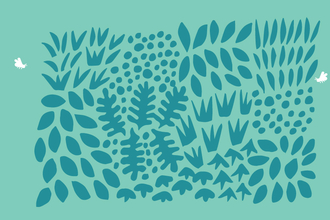I don't know about you but I've seen more ivy in flower than usual this November. It's not a plant I think much about at this time of year; it's an incredibly important source of nectar for insects in late summer and early autumn, its bounty of berries provide vital food for birds in late winter and its curtain of leaves offer shelter all year round. Perhaps the hot summer prompted a few plants to delay flowering for a few weeks but the sheer number of varieties of ivy can mean that there's an ivy in flower somewhere from August to December. On sunny days this month I've seen hoverflies, wasps, bumblebees, flies and butterflies crowded around ivy flowers and on some plants I've seen nectar-rich flowers and forming berries just centimetres apart.
Ivy
Ivy flowers by Wendy Carter
To the untrained eye (or the tidiest of gardeners), ivy is just a plant that clambers up walls and trees. Take a closer look, though, and you'll find that it provides food and shelter for a lot of wildlife. The many varieties of ivy provide a range of flowering and fruiting seasons. Some begin to flower before the end of August whereas others don't start to flower until late September or even October. Whilst the late flowerers are serving up sweet nectar to insects, the early flowerers are already developing berries to feed the birds and these blue-black delights can last well beyond Christmas, providing food in the depths of winter. In fact, with a high fat content, the berries are one of the most nutritious food sources for birds (although they're moderately poisonous for mammals). As if flowers and berries weren't enough, there are numerous moth species that eat the waxy leaves.

Redwing in ivy by Wendy Carter
Ivy offers more than just food. Its dense foliage can provide shelter throughout the year but it really comes into its own during winter when it offers much-needed protection from the elements for butterflies, moths, spiders, shieldbugs and many more species of wildlife. Brimstone butterflies, for example, emerge in mid to late summer and live for about a year; ivy offers a perfect hideaway. Particularly thick tangles of ivy offer excellent roosting spots for familiar garden friends such as blackbirds, wrens and robins.
Whilst I, and other wildlife-lovers, think that ivy should be celebrated, I can understand why some people get fed up with it. It has an amazing ability to wander where it might not be wanted. On suitable surfaces, armed with sucker-like aerial roots, it's been found 100m above ground level, its twining stems winding around other plants to help keep it in position. This can constrict smaller plants but, contrary to belief, it doesn't strangle or harm the trees it's often seen growing up (particularly heavy growth can create competition for nutrients and water but it's not a great risk). Heavy ivy growth in the tops of decaying trees can create a 'sail' that might lead to damage in high winds but, in some circumstances, it can help to anchor a feeble tree and almost certainly can help to make a dying tree into an important and long-lasting wildlife resource.
As an evergreen plant, it has long been believed that ivy symbolises fidelity and protection. In the past, ivy was woven into plaits and wreaths and hung in cattle byres to protect the livestock and, although some of us may not appreciate it growing up the walls of our houses, it used to be deliberately encouraged to do so in order to protect those within. There's evidence now that it helps to insulate buildings and can also help to protect masonry from the effects of both weather and pollution.
Ivy is, of course, also linked to next month's Christmas season. In the song, The Holly and the Ivy, the holly represents the crown of thorns worn by Jesus (the red berries are drops of blood) and the ivy is said to represent the Virgin Mary. Combine this with the more pagan folklore about fertility and protection and you have ivy being used in decorations for hundreds, if not thousands, of years.

Ivy by Wendy Carter
If you're itching to prune the ivy in your garden, think about how best to manage it for you and for wildlife. If you can bear to leave it over winter, please do so. I cut mine back in early spring, once the berries have been eaten and the temperature is a little warmer for any snoozing insects that I might disturb. As well as all the benefits that it can bring to individuals, it also provides a great piece of connectivity for wildlife moving through the landscape from hedgerows to gardens. Green borders of any kind, whether it be native hedgerows or climbers that cover otherwise bare walls and fences, are really important to help wildlife move between suitable habitats.



